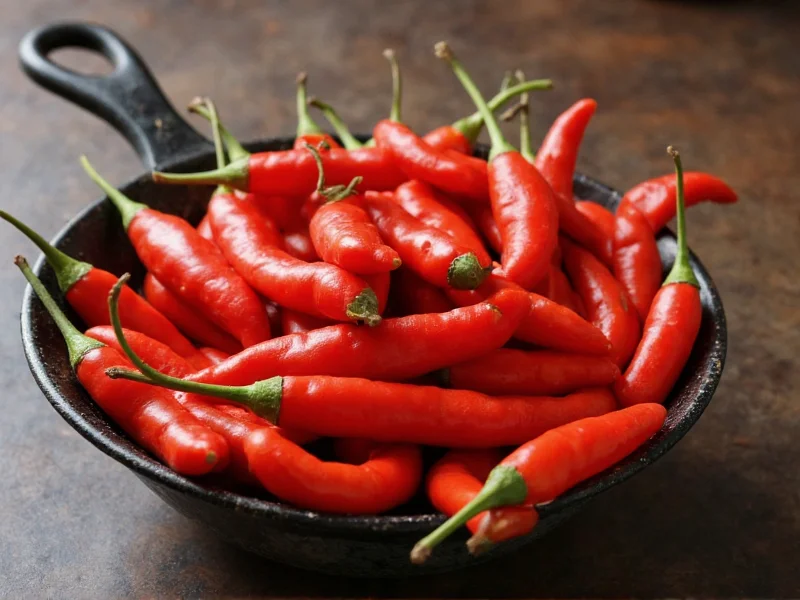Understanding the distinction between chiles and ajíes is essential for anyone exploring Latin American and Caribbean cuisines. This confusion stems from linguistic variations across Spanish-speaking regions rather than botanical differences. The Capsicum family includes numerous varieties that range from mild to extremely hot, each with unique flavor profiles and culinary applications.
Regional Terminology Explained
The term "chile" (pronounced "chee-leh") originates from the Nahuatl word "chilli" and is primarily used in Mexico and Central America. In contrast, "ají" (pronounced "ah-hee") comes from the Taíno word "axí" and is favored in many South American countries, the Caribbean, and parts of Spain. This linguistic variation explains why the same pepper might be called by different names depending on geographic location.
For example, what Mexicans call "chile de árbol" might be referred to as "ají" in Dominican Republic or Cuba. Similarly, the habanero pepper is known as "chile habanero" in Mexico but often simply as "ají" in other regions. This terminology difference frequently causes confusion among cooking enthusiasts and recipe developers working across cultural boundaries.
Common Varieties of Chiles and Ajíes
Despite the naming differences, the peppers themselves share similar characteristics across regions. Below is a comparison of popular varieties:
| Common Name | Regional Terminology | Scoville Heat Units | Flavor Profile |
|---|---|---|---|
| Habanero | Chile habanero (MX), Ají (Caribbean) | 100,000-350,000 SHU | Fruity, floral, intensely hot |
| Jalapeño | Chile jalapeño (MX), Less common as ají | 2,500-8,000 SHU | Grassy, bright, moderately hot |
| Scotch Bonnet | Rarely called chile, typically ají | 100,000-350,000 SHU | Tropical fruit notes, very hot |
| Aji Amarillo | Almost exclusively called ají | 30,000-50,000 SHU | Bright, fruity, medium heat |
| Serrano | Chile serrano (MX), Occasionally ají | 10,000-23,000 SHU | Sharp, clean heat, crisp flavor |
Culinary Applications Across Regions
The difference between chiles and ajies extends to their culinary applications. Mexican cuisine typically features chiles in complex mole sauces, salsas, and as roasted toppings. South American and Caribbean cooking often incorporates ajíes into bright, acidic preparations like Peruvian aji sauces or Caribbean hot sauces.
When exploring authentic recipes, understanding these regional distinctions helps prevent confusion. For instance, a recipe calling for "ají limo" in Peru refers to a specific variety of hot pepper, while "chile limo" in Yucatán refers to the same botanical variety but within a different culinary context. This knowledge proves invaluable for home cooks seeking authentic flavors when working with traditional Latin American and Caribbean recipes.
Understanding Heat Levels and Flavor Profiles
One of the most important aspects of working with chiles and ajies is understanding their heat levels and flavor characteristics. The Scoville scale measures capsaicin concentration, but flavor complexity goes beyond mere heat measurement. Many ajies varieties, particularly those from South America, offer distinctive fruity or floral notes that balance their heat.
For example, the aji amarillo (yellow chili) common in Peruvian cuisine delivers moderate heat with pronounced tropical fruit flavors, making it ideal for creamy sauces. Meanwhile, Mexican chiles like the guajillo provide earthy, berry-like notes with mild to medium heat, perfect for complex mole preparations. Recognizing these flavor differences helps cooks select appropriate peppers for specific dishes rather than focusing solely on heat level.
Growing Chiles and Ajies at Home
Gardeners interested in growing these peppers should know that most varieties thrive in similar conditions regardless of their regional naming. They require warm temperatures, well-draining soil, and consistent watering. The main difference lies in selecting varieties appropriate for your culinary interests.
For those exploring Mexican cuisine, starting with jalapeños, serranos, and poblanos makes sense. Those interested in South American and Caribbean cooking might prioritize aji amarillo, aji limo, or habanero varieties. Many garden centers now label plants with both regional names to help consumers find the varieties they need for specific recipes.
Nutritional Benefits of Chile Peppers
Both chiles and ajies offer significant health benefits beyond their culinary value. They're rich in vitamin C, capsaicin (which has anti-inflammatory properties), and various antioxidants. Regular consumption of moderate amounts of these peppers has been linked to improved metabolism, cardiovascular health, and pain relief.
The capsaicin content varies significantly between varieties, which explains why some peppers deliver intense heat while others provide more subtle warmth. This compound not only creates the burning sensation but also triggers the release of endorphins, creating the pleasurable "heat high" many pepper enthusiasts seek. Understanding these biological effects helps explain why chile peppers have become integral to so many global cuisines.
Frequently Asked Questions
What's the difference between chiles and ajies?
Chiles and ajies both refer to chili peppers in Spanish, with regional variations in usage. 'Chiles' is predominantly used in Mexico while 'ajies' is more common in South American and Caribbean countries. They describe the same types of peppers but with different regional naming conventions.
Can I substitute chiles for ajies in recipes?
Yes, you can generally substitute chiles for ajies in recipes, but you should match the heat level and flavor profile. For example, habanero chiles can substitute for habanero ajies, but a mild poblano chile wouldn't work as a substitute for a hot ají limo. Always consider the specific variety's characteristics rather than just the regional name.
Which is hotter, chiles or ajies?
Neither term indicates heat level. Both 'chiles' and 'ajies' encompass peppers ranging from mild to extremely hot. Heat depends on the specific variety, not the regional name. For example, both Mexican chiles (like habaneros) and South American ajies (like ají limo) include some of the world's hottest peppers.
Why do some regions use 'chiles' while others use 'ajies'?
The terminology difference stems from linguistic history. 'Chile' comes from the Nahuatl word 'chilli' and is used primarily in Mexico and Central America. 'Ají' originates from the Taíno word 'axí' and is favored in South America, the Caribbean, and parts of Spain. This reflects the different indigenous influences in various regions of the Spanish-speaking world.











 浙公网安备
33010002000092号
浙公网安备
33010002000092号 浙B2-20120091-4
浙B2-20120091-4